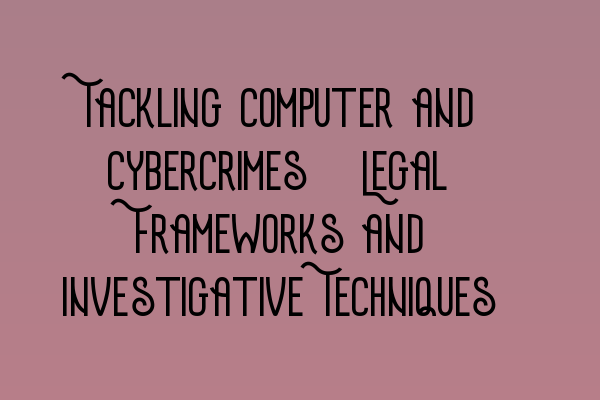Tackling Computer and Cybercrimes: Legal Frameworks and Investigative Techniques
Computer and cybercrimes have become prevalent in today’s digital age. With the increasing reliance on technology, criminals have found new ways to exploit it for their unlawful activities. As a result, legal frameworks and investigative techniques have evolved to combat these crimes effectively.
The Legal Framework
The legal framework surrounding computer and cybercrimes encompasses various statutes and regulations aimed at criminalizing and prosecuting offenders. These laws include:
- SQE 1 Practice Exam Questions
- SQE 1 Practice Mocks FLK1 FLK2
- SQE 2 Preparation Courses
- SQE 1 Preparation Courses
- SRA SQE Exam Dates
One of the key pieces of legislation for tackling computer and cybercrimes is the Computer Misuse Act 1990. This act criminalizes unauthorized access, modification, and disruption of computer systems. It covers a wide range of offenses, including hacking, malware distribution, and denial-of-service attacks.
Another important legislation is the Data Protection Act 2018, which aims to protect individuals’ personal data. It sets out guidelines for collecting, processing, and storing data securely. Any unauthorized access or misuse of personal data constitutes a criminal offense under this act.
Furthermore, the Investigatory Powers Act 2016 grants intelligence and law enforcement agencies certain powers to intercept communications, obtain warrants, and conduct surveillance in the interest of national security.
Investigative Techniques
Investigating computer and cybercrimes requires specialized knowledge and expertise. Law enforcement agencies and legal professionals employ various techniques and tools to gather evidence and track down offenders.
Some commonly used investigative techniques include:
- Digital Forensics: This involves the analysis of digital devices, such as computers, smartphones, and servers, to extract evidence. Forensic experts use specialized software and techniques to recover deleted files, trace online activities, and identify perpetrators.
- Network Monitoring: Law enforcement agencies often monitor networks and internet traffic to detect suspicious activities. This allows them to identify potential threats and gather evidence for prosecuting cybercriminals.
- Social Engineering: Investigators may use social engineering techniques to gather information or gain access to restricted systems. This involves manipulating individuals through deception or psychological tactics to obtain relevant data or access credentials.
- Cyber Intelligence: Gathering intelligence on cybercriminals and their activities is crucial for successful prosecution. This involves monitoring online forums, analyzing malware samples, and tracking digital footprints to identify and apprehend offenders.
By combining these techniques with advanced technological tools, law enforcement agencies and legal professionals can stay ahead in the fight against computer and cybercrimes.
Conclusion
As computer and cybercrimes continue to pose significant threats in our digital society, legal frameworks and investigative techniques must evolve to tackle these challenges effectively. The Computer Misuse Act 1990, Data Protection Act 2018, and Investigatory Powers Act 2016 form the foundation for prosecuting offenders and safeguarding individuals’ digital rights.
Law enforcement agencies and legal professionals need to stay up-to-date with emerging technologies and hone their investigative skills to combat the ever-evolving landscape of computer and cybercrimes.
For more information on preparing for SQE exams and advancing your legal career, check out our related articles:
